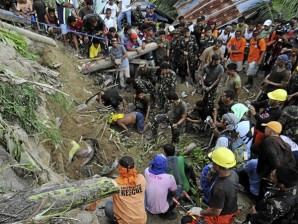LA LIBERTAD, Negros Oriental—Survivors of a deadly 6.9-magnitude earthquake begged rescuers on Wednesday to keep searching for dozens of people buried in landslides, but officials said hopes of finding them alive were dim.
Two days after the quake flattened homes, destroyed bridges and crumbled mountainsides, rescue workers battled without heavy equipment to dig through rubble in the search for the missing.
“Please do not give up, please continue searching,” 47-year-old housewife Virginita Magalso sobbed, her face streaked with dirt, as rescuers picked through mounds of dirt that covered the homes of family and friends.
“We can still save them, miracles happen all the time.”
Magalso said her 68-year-old mother, an older brother, his wife, and their two young children were among those buried when part of a hill collapsed on homes in this farming community.
Her house was further down the slope, sparing her own family certain death, she said.
Very slim chance
Governor Roel Degamo said the chances of finding anyone alive were very slim.
“We are in a state of shock, and all we can do now for those still missing is to pray,” Degamo told AFP.
He said soldiers and rescuers in La Libertad raced Wednesday to find a young woman who had sent a mobile phone text message to her relatives that she was pinned down, but alive.
The search, however, ended in tears hours later.
“She was found dead and still clutching her cell phone,” Degamo said.
Official death toll
The regional military commander tasked with the responsibility for the disaster zone, Colonel Francisco Patrimonio, reported Wednesday that 48 people had died, and another 92 were missing.
But the Army said in a statement on Wednesday that the confirmed number of deaths was just 26, blaming the initial confusion in the quake-hit areas for the change in numbers.
The revised tally matched figures from the National Disaster Risk Reduction and Management Council, the overall emergency response agency.
“Rescue teams have so far not seen or heard any signs of life underneath,” Guihulngan Mayor Ernesto Reyes told Agence France Presse, adding 29 people were believed buried in one disaster-hit village.
“None of our missing have so far been retrieved.”
Reyes said Sitio (sub-village) Moog in Barangay (village) Planas was buried under about 10 metres (30 feet) of debris, with rescue efforts painfully slow because people had only picks, shovels and their bare hands to claw through the dirt.
Roads and bridges to Guihulngan, a coastal city of about 100,000 flanked by mountains, were badly damaged in the quake and rescuers had difficulty bringing in earth movers and supplies to the survivors.
Shocks hamper rescue
Strong aftershocks have also hampered the rescue operations in Guihulngan and La Libertad.
In Planas, the rescuers temporarily stopped following a strong aftershock at 11:45 a.m. Wednesday. Rocks started to fall from the mountains, prompting them to pull back.
“But we are not withdrawing,” said Colonel Francisco Patrimonio, commandering officer of the Army’s 302nd Infantry Brigade. “We had to distance ourselves or else our rescuers would become casualties,” he added.
Francis Cortes, medical technician of the Emergency Rescue Unit Foundation based in Cebu City, said “the ground was soft and there were rocks falling from the mountains.” He said he felt at least 20 aftershocks.
But rescue efforts continued in Barangay Solonggon in La Libertad, said Lieutenant Colonel Ramil Bitong, commanding officer of the 11th Infantry Battalion.
“The landslide area is huge. Anytime, it might slide again so it’s highly risky for rescuers,” Bitong said in a phone interview.
Two backhoes owned by the municipality were being used to dig the landslide site where houses were buried 30 to 40 feet, Representative Josie Limkaichong (first district) said.
“Our immediate concern now is how to serve the living. We don’t have enough food, there is no electricity and water,” Guihulngan Mayor Reyes said. “We are appealing for help from everyone.”
Army deployment
In Manila, civil defense chief Benito Ramos said five military battalions, or about 2,000 troops, had been deployed to the devastated zones and were helping local rescue units.
“We are racing against time, and hoping against hope that maybe, just maybe some of them might still be alive,” he said.
At least two mechanical diggers (backhoes) and several chainsaws and drills had reached La Libertad, but other areas remained cut off, according to Ramos. Reports from Florence Baesa, Jhunnex Napallacan and Connie E. Fernandez, Inquirer Visayas; and AFP
